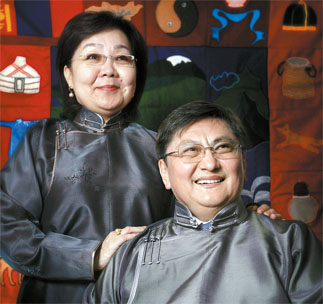[Kitchen Talk]Farsighted Mongolian culture

Mongolian Ambassador D. Gerel with his wife at the Mongolian ambassador’s residency. By Jeong Chi-ho
Here is why. One myth surrounding Mongolia is that its people’s eyesight is said to be the best. The logic is that the country’s wide open steppe allows people to see from a very young age to the far horizon, an excellent way to train your eyes.
Whatever the truth, the perfect gal-spotting eagle eye is just what I need to distance myself from unnecessary romantic encounters. But the real catalyst for my enthusiasm for this country was a meal at the residency of Mongolian Ambassador D. Gerel in Hannam-dong.
The harsh climate, with winter temperatures as low as minus 40 degrees Celsius (- 40 degrees Fahrenheit), has always played a role in shaping the culinary art of Mongolia because as nomads moving from place to place, with a fierce headwind beating down on them, Mongols needed a healthy dose of animal fat to sustain their body.
Thus cooking was centered around dairy products and meat. No surprise that cheese curds with salted tea and a hint of milk were there to greet me at the ambassador’s residency. “Some people put in butter because of the cold weather,” said the ambassador’s wife, Mrs. Gerel, further confirming what Wikipedia had told me. “It’s almost like a soup.”
The festivities started with slices of lamb served cold plus a glass of Mongolian vodka. Then came rolled up mini pancakes similar to Indian naan bread but much smaller. They are just moist enough to whet my appetite. But I barely contain my eyes in their sockets when I see what’s next to eat. This was the kind of dish you can smell a mile away and that gets your stomach juices flowing.
Enter dumpling soup with dried beef and vegetables.
I told myself: “Remain calm and professional.” In this line of work, nodding the head is mandatory to get the other side talking even when the story is boring or the food is bad. Not this time. I was almost losing it.
Our host explained that in a country where the average temperature during the long wintertime is very low, drying meat has been a habit since the nomadic days of the Mongolians.
“It’s very natural for us,” said the ambassador. Meanwhile, I am busy sending the dumplings to every corner of my mouth while trying to keep my mind working.
People tend to relax when they eat and my curiosity let me ask Ambassador Gerel, who experienced the transformation from socialism to a market-driven society firsthand, what sort of feelings he experienced as people gained their freedom of speech.
“Today, we have so many newspapers in Mongolia and people read them all,” said the ambassador. “That’s a good sign of people wanting to express their opinions.”
After gaining independence from China in 1921 with the Soviet Union’s support, a communist party ruled until the collapse of the Soviet Union. The country embraced a democratic revolution and the subsequent reforms transformed it into a free market economy.
Today, there are close to 35,000 Mongolians in Korea, though it would be hard to tell us apart. (Koreans and Mongolians look so similar.) Business professionals and students make up the bulk and the ambassador hopes he can improve further bilateral ties. “We are trying to send more Mongol students to Korea especially in advanced science areas.”
The ambassador, who arrived in Korea in April, has already hosted a forum with NGOs on how to combat rising problems such the yellow dust that visits Korea every year.
For those who want to know more, I strongly recommend “Genghis Khan and the Making of the Modern World” by Jack Weatherford.
He argues Genghis Khan gets much less respect than the Romans. I suspect the perception created by those he conquered played a great role in this. Nobody in Europe today talks about the killings that the Roman army carried out. It’s considered an internal affair. But the Mongol attacks were viewed as a threat from the outside to Europe’s civilization. And that’s different.
“[Genghis Khan’s] ideas were so far reaching and ahead of their time. He understood what globalization really meant,” the ambassador said.
This point is underlined by Weatherford as well. “Genghis Khan granted universal religious freedom and smashed feudal systems of aristocratic privilege. He took the disjointed and languorous trading towns along the Silk Route and organized them into history’s largest free-trade zone,” he writes.
When in doubt, what better way to see for yourself where it all started. Mrs. Gerel recommended visiting the country during its Naadam festival held in July.
The festival has its roots in the nomad wedding assemblies and hunting of the Mongol Army. It consists of three traditional Mongolian sports - archery, horse riding and wrestling. Needless to say it’s a place where one can see many people and taste a mountain of food, quintessential pillars to know a foreign culture.
By Brian Lee Staff Reporter [africanu@joongang.co.kr]










with the Korea JoongAng Daily
To write comments, please log in to one of the accounts.
Standards Board Policy (0/250자)